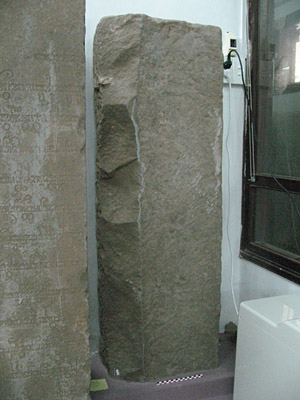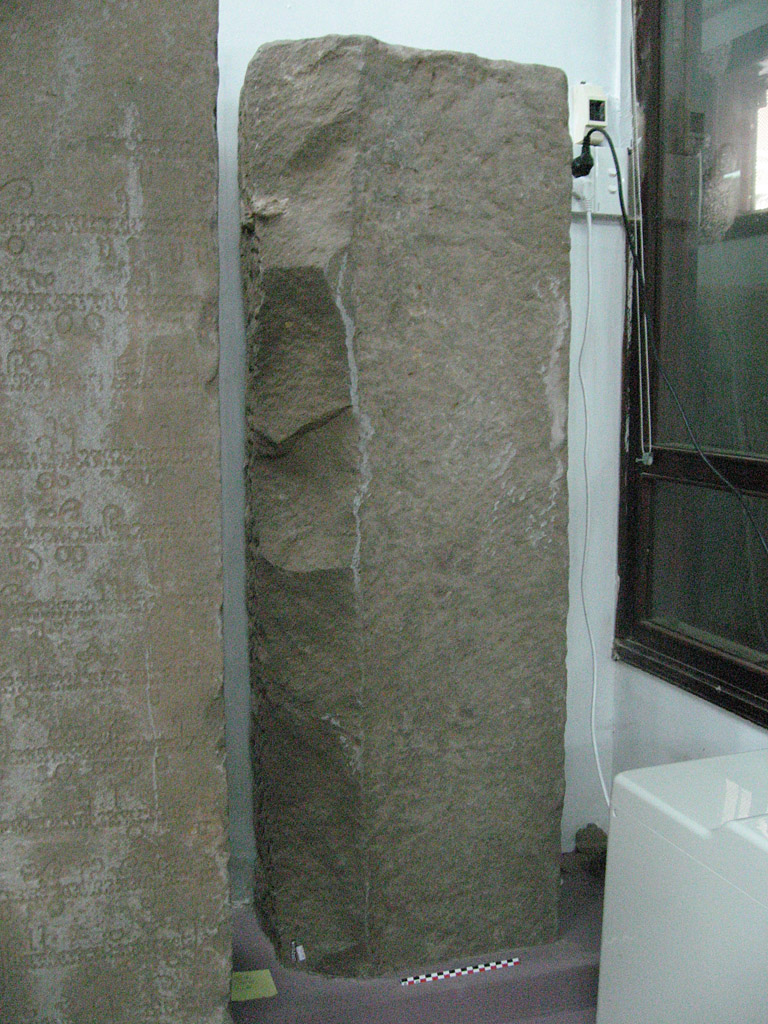Corpus of the Inscriptions of Campā




C. 6 Lintel from Phan Rang
Please note: you are reviewing a preprint version of this publication. Contents here may change significantly in future versions. Scholars with specific interests are urged to consult all cited bibliography before using our texts and translations or drawing other significant conclusions.
Text Four lines on one face written in Old Cam.
Date Text 1: 1166 Śaka (1244/5 CE). Text 2: 1196 Śaka (1274/5 CE).
Origin Town of Phan Rang (Ninh Thuân, Vietnam).
This lintel was found before 1888, but was first mentioned in the literature only in Finot 1903: 648. During the first decade of the 20th century, it was observed at the Phan Rang residence (Parmentier 1909: 79-81). Like the architectural elements bearing C. 3, C. 4, C. 5 and C. 7, this one was later identified as belonging to a group of vestiges, found in the rice-fields of the Catholic Mission, to which the designation “sanctuaire de Svayamutpanna” was applied (Parmentier 1918: 77). When the inscriptions of Campā were moved from the Saigon Museum to the EFEO Museum in Hanoi in 1910, the collection was completed by other inscriptions regarded as being of outstanding importance for the history of Campā. The lintel bearing C. 6 was one of them (Finot 1915a: 2). Its inventory number B 2, 18 at the Museum was published in Finot 1915a: 10; whence, in the inventory of Campā inscriptions published in 1923, this local number was included under the entry C. 6 (Cœdès 1923). We identified the stone in the Bảo Tàng Lịch Sử Việt Nam (National Museum of Vietnamese History) at Hanoi in 2009 and following years, as the one bearing inventory number LSb 21178. The Museum assumed the new name Bảo Tàng Lịch Sử Quốc Gia (National Museum of History) in 2011, but this did not entail a change in the inventory number.
Edition(s) This inscription was edited and translated into French in Finot 1903: 648; summarised in English in Majumdar 1927: 213, whence Golzio 2004: 180 and 191. It was also studied in Jacques 1977-1978: 1078-1079. The present edition and translation after ECIC IV: 226-228.
Facsimiles
- Estampage: EFEO 4
- Estampage: EFEO n. 146
The following text was edited by Arlo Griffiths and Amandine Lepoutre.
C. 6.1
C. 6.2
1 pāṇḍurāṅgeśvara ◇ pāṇḍuraṅgeśvara Finot. — 2 9 ◇ 7 Finot. — 8 ◇ 9 Finot. — suvauk ◇ suvok Finot. — 8 ◇ 9 Finot. — calāhvaya ◇ valāhvaya Finot. — 3 oṅ ◇ yāṅ Finot. — nandana ◇ takdata Finot. — tur(e) ◇ tute Finot. the fact that Finot used italics in his publication shows that he was not sure about his reading of the second akṣara. The present reading re is based on the comparison of this occurrence, ture vijaya, and equivalents found in other inscriptions, namely turai vijaya and turaiy vijaya (see, C. 5, l. 18; C. 30 B2, l. 1; C. 30 B4, l. 2 and C. 86.1, l. 2. The distinct form of the ai sign further on (in l. 3: vrim̃ rai lyam̃) prevents us from reading turai. The most satisfactory alternative is to read ture and understand turai. — utpaṇa ◇ utpaṇna could also be read. — 1196 ◇ 1176 Finot. — sraum̃ ◇ praum̃ Finot. — svayamutpaṇna ◇ svayamutpaṇṇa Finot. — 4 avyaṁ ◇ avya Finot. — 1196 ◇ 1176 Finot.
Translations
English
C. 6.1
Hail! P.P. man Paṅkaja, prince Abhimanyudeva, person of Cathim̃ Pāṇḍurāṅgeśvara, general of Y.P.K. Jaya Parameśvaravarmadeva. This P.P.T.R. invited this Pom̃ to go [as] general to Panrāṅ in this Śaka year 1152 on behalf of this king P.P.T.R.
Moreover, this Pom̃ offered to Y.P.K. Svayamutpanna in this Śaka year 1166: a golden vom̃ sān mvram̃m weighing 9 thil 4 draṁ of gold; a silver vom̃ sān mvram̃m weighing 8 thil of silver; a silver cult plate weighing 8 thil; a calāhvaya of cuprous metal.
C. 6.2
Taval Śūratva, Mr. Mādhavaḥ Nandana, person of Turai Vijaya. The P.P.T.R. Indravarman invited [him] to go [as] L.P. [to] the god Utpaṇa in the Śaka year 1196. He bought: a male elephant ma anan (?) ja Sraum̃; 6 servants to be offered to Y.P.K. Svayamutpanna: mauk Karet, mauk Ratna Dāk, mauk Avyaṁ, mauk Eḥ, mauk Can, mauk Pūt [as well as a] tralām̃ tāra [in] 1196.
French
C. 6.1
Salut ! P.P. homme Paṅkaja, prince Abhimanyudeva, personne de Cathim̃ Pāṇḍurāṅgeśvara, général de Y.P.K. Jaya Parameśvaravarmadeva. Ce P.P.T.R. invita ce Pom̃ à aller [en tant que] général à Panrāṅ en cette année 1152 Śaka pour ce roi P.P.T.R.
De plus, ce Pom̃ offrit à Y.P.K. Svayamutpanna en cette année 1166 Śaka : vom̃ sān mvram̃m en or pesant 9 thil 4 draṁ d'or ; vom̃ sān mvram̃m en argent pesant 8 thil d'argent ; un plateau de culte en argent pesant 8 thil ; un calāhvaya en metal cuivreux.
C. 6.2
Taval Śūratva, M. Mādhavaḥ Nandana, personne de Turai Vijaya. Le P.P.T.R. Indravarman [l'] invita à aller [en tant que] L.P. [au] dieu Utpaṇa en l'année 1196 Śaka. Il a acheté : un éléphant mâle ma anan (?) ja Sraum̃ ; 6 serviteurs à offrir au Y.P.K. Svayamutpanna : mauk Karet, mauk Ratna Dāk, mauk Avyaṁ, mauk Eḥ, mauk Can, mauk Pūt (ainsi qu'un) tralām̃ tāra (en) 1196.
Secondary Bibliography
- Parmentier 1909: 79-81.
- Finot 1915a: 2 and 10.
- Parmentier 1918: 77.


